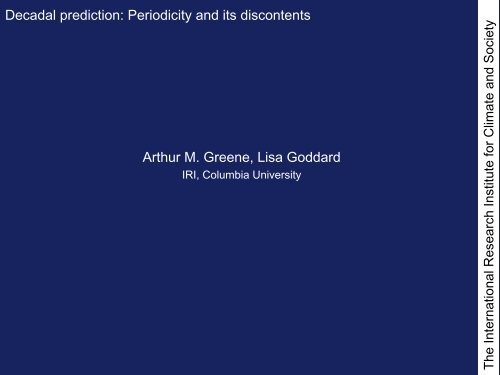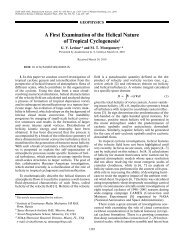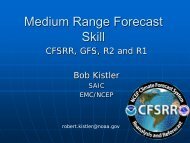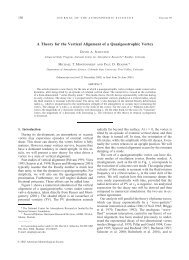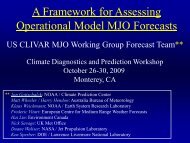Decadal prediction: Periodicity and its discontents Arthur M. Greene ...
Decadal prediction: Periodicity and its discontents Arthur M. Greene ...
Decadal prediction: Periodicity and its discontents Arthur M. Greene ...
- No tags were found...
You also want an ePaper? Increase the reach of your titles
YUMPU automatically turns print PDFs into web optimized ePapers that Google loves.
The International Research Institute for Climate <strong>and</strong> Society<strong>Decadal</strong> <strong>prediction</strong>: <strong>Periodicity</strong> <strong>and</strong> <strong>its</strong> <strong>discontents</strong><strong>Arthur</strong> M. <strong>Greene</strong>, Lisa GoddardIRI, Columbia University
Motivation• Sources of low-frequency climate variability– Response to external forcing– Internal, possibly periodic processes– Integration by the ocean of weather noise forcing• These components may be separable <strong>and</strong>, to differingdegrees, either amenable to <strong>prediction</strong> or useful forcharacterizing uncertainty in decadal forecasts.The International Research Institute for Climate <strong>and</strong> Society
Signal decomposition• Define forced component– Linear trend– Globally averaged Ts– Scaled multimodel mean– PC of first S/N-maximizing EOF• Filter interannual variability– Not predictable on decadal time horizons– Implicit contribution to forecast uncertainty• <strong>Decadal</strong> signal is what remains– Test for periodicity against red-noise H0– Project periodic components forward• Nonperiodic residual assigned to forecast uncertaintyThe International Research Institute for Climate <strong>and</strong> Society
One realization of the conceptual modelRobertson et al. 2001• Forecast of Paraná riverstreamflow, ten-year lead.• Singular spectrum analysis (SSA)used for signal detection againstautocorrelated noise background.• Two components, with periods 8,17 yr, are identified (a).• Each component projectedforward using linear <strong>prediction</strong>,projections then combined (b).• Categorical hindcast skill claimed.• Interannual variability appears aserror bar.• Periodic behavior attributed tovariability in N. Atlantic <strong>and</strong> SouthAmerican low-level jet.The International Research Institute for Climate <strong>and</strong> Society
The International Research Institute for Climate <strong>and</strong> SocietyAn idealized example• Signal: T = 20yr, n = 200• Noise: AR(1), = 0.5S/N = 0 dB• Trend: 1.0 º / century
Monte Carlo singular spectrum analysis• Eigendecomposition of thelagged covariance matrix.• Eigenvalues constitute thesingular spectrum.• Confidence intervals based oncalibrated AR(1) noise.• Paired eigenvalues of oppositeparity that rise above the CIsuggest the presence of anoscillatory component.• Such a component is indicatedhere at frequency 0.05 yr -1 .The International Research Institute for Climate <strong>and</strong> Society
Forward projection• Reconstructions of the periodicsignal (blue) are generated ona 100-yr sliding window. (SSAused as a b<strong>and</strong>pass filter.)• Each is then projected forward10 yr, generating a <strong>prediction</strong>plume (red).• Predictions anticipate phase ofverifying signal (green) quitewell, as might be expected.• Q: What is “useful” skill?The International Research Institute for Climate <strong>and</strong> Society
Real-world example: DJF rainfall for southern Africa• Map: DJF Climatology• Dipolar structure (butextreme SW, with JJAmaximum, is excluded).• Some evidence ofdecadal variations.The International Research Institute for Climate <strong>and</strong> Society
SSA detection <strong>and</strong> forward projection• Oscillatory signal detected,period ~ 20 yr.• Forecasts track verificationquite well (ACC), but:• Short length of series rendersskill assessment difficult:– Only 6 verification cycles– Cannot reduce RC length– Behavior of verifying signalsubject to edge effects• Useful role for paleodata.• In Western Cape, rainfall maxoccurs in JJA, where noperiodic signal is detected.• <strong>Decadal</strong> variance can be usedin uncertainty estimates.The International Research Institute for Climate <strong>and</strong> Society
Summary• Signals that are “sufficiently” regular may be identified,projected forward in time.• Illustrated here: SSA for detection <strong>and</strong> as a b<strong>and</strong>passfilter; linear <strong>prediction</strong> to generate forecasts. Othermodes may be possible.• For the decadal b<strong>and</strong>, 100-yr records are of marginallength, suggesting a role for paleodata.• S/N is a measure of utility.• Helpful, if not essential, to provide a plausible physicalbasis for inferred periodicity.The International Research Institute for Climate <strong>and</strong> Society
The International Research Institute for Climate <strong>and</strong> SocietyThank you!amg@iri.columbia.edu


